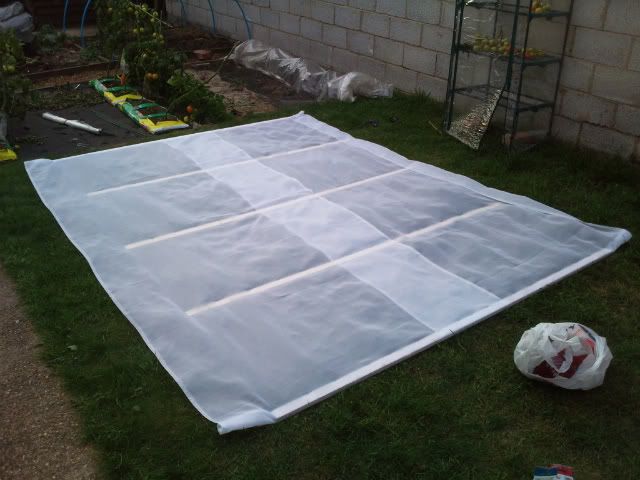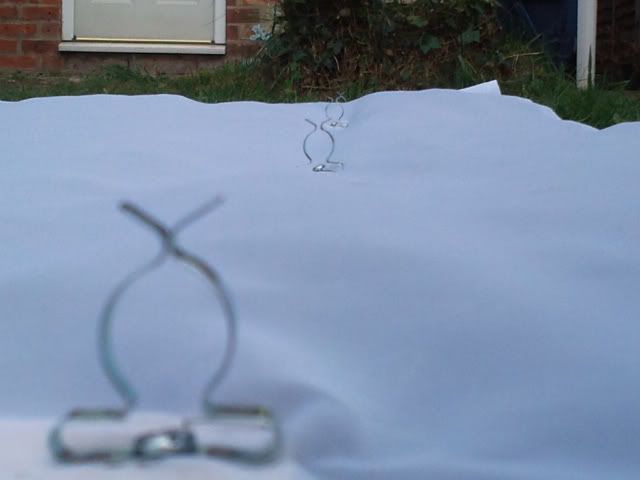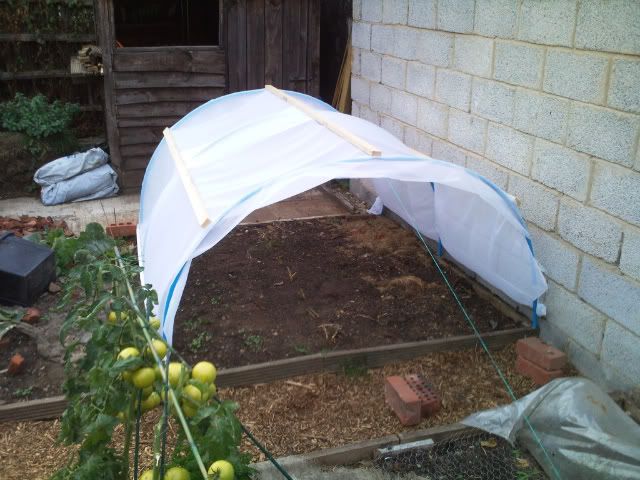I wanted to build a net frame to protect my brassicas for next year having lost the whole lot to caterpillar damage this year.
My problem was getting my hands on enough cheap wood to constuct a suitable frame, and also to make it such that it was easily accessible, moveable and removeable.
I came up with the following idea:

I used 3 lengths of 20mm blue mains water pipe. This is held in place by 6 lengths of 16mm dowel, glued into holes bored in the raised bed wood. The blue pipe slots onto this so that it can be removed when needed.

I then took two 1x3.5m lengths of voile (£1.90 per 1x1m) and stapled it to 5 lengths of timber I pilfered off my brother.

I screwed three of these metal clips onto the ends of each length of wood, one at each end, and one down the middle.

The timber then clips onto the blue pipes in such a way that it can be slid backwards and forwards along the pipes to cover/uncover the bed. I also have some voile to cover the ends, but am still considering the best way in which to do this.
Should I wish to, I can reproduce the covering using polythene to produce an identical polytunnel. If I decide I no longer want the tunnel at all, the whole thing can be dismantled and flat-packed down the side of the shed without the use of any tools.
Issues:
I opted for 20mm rather than 25mm water pipe because I was concerned that the larger pipe would not fit on the boards. In hindsight I have discovered that the 20mm is a little too flimzy and tried its hardest to buckle under the weight of the timbers. This is why, in the last picture, you can probably see a guide-string I pt in place to ensure it didn't blow down.
Unfortunately the distance between the 1st and 3rd pipe at one end of the pipe is shorter than the other end. As a result I need to remove the cover and re-position some of the clips before it will successfully connect. This also limits the distance you can slide the cover back before the alignment is so far out it obstructs the rungs.
The middle pipe protrudes further out that the outside two at the left end. This means the last rung has to bend to get into position. This causes the clips to spring off unless it's kept in position with bricks.
My problem was getting my hands on enough cheap wood to constuct a suitable frame, and also to make it such that it was easily accessible, moveable and removeable.
I came up with the following idea:

I used 3 lengths of 20mm blue mains water pipe. This is held in place by 6 lengths of 16mm dowel, glued into holes bored in the raised bed wood. The blue pipe slots onto this so that it can be removed when needed.

I then took two 1x3.5m lengths of voile (£1.90 per 1x1m) and stapled it to 5 lengths of timber I pilfered off my brother.

I screwed three of these metal clips onto the ends of each length of wood, one at each end, and one down the middle.

The timber then clips onto the blue pipes in such a way that it can be slid backwards and forwards along the pipes to cover/uncover the bed. I also have some voile to cover the ends, but am still considering the best way in which to do this.
Should I wish to, I can reproduce the covering using polythene to produce an identical polytunnel. If I decide I no longer want the tunnel at all, the whole thing can be dismantled and flat-packed down the side of the shed without the use of any tools.
Issues:
I opted for 20mm rather than 25mm water pipe because I was concerned that the larger pipe would not fit on the boards. In hindsight I have discovered that the 20mm is a little too flimzy and tried its hardest to buckle under the weight of the timbers. This is why, in the last picture, you can probably see a guide-string I pt in place to ensure it didn't blow down.
Unfortunately the distance between the 1st and 3rd pipe at one end of the pipe is shorter than the other end. As a result I need to remove the cover and re-position some of the clips before it will successfully connect. This also limits the distance you can slide the cover back before the alignment is so far out it obstructs the rungs.
The middle pipe protrudes further out that the outside two at the left end. This means the last rung has to bend to get into position. This causes the clips to spring off unless it's kept in position with bricks.



 that piping is perfect for cloching
that piping is perfect for cloching






 mst say I never thought about clips,my version for next year is here.It's really easy to open/close and can be moved from bed to bed
mst say I never thought about clips,my version for next year is here.It's really easy to open/close and can be moved from bed to bed
Comment